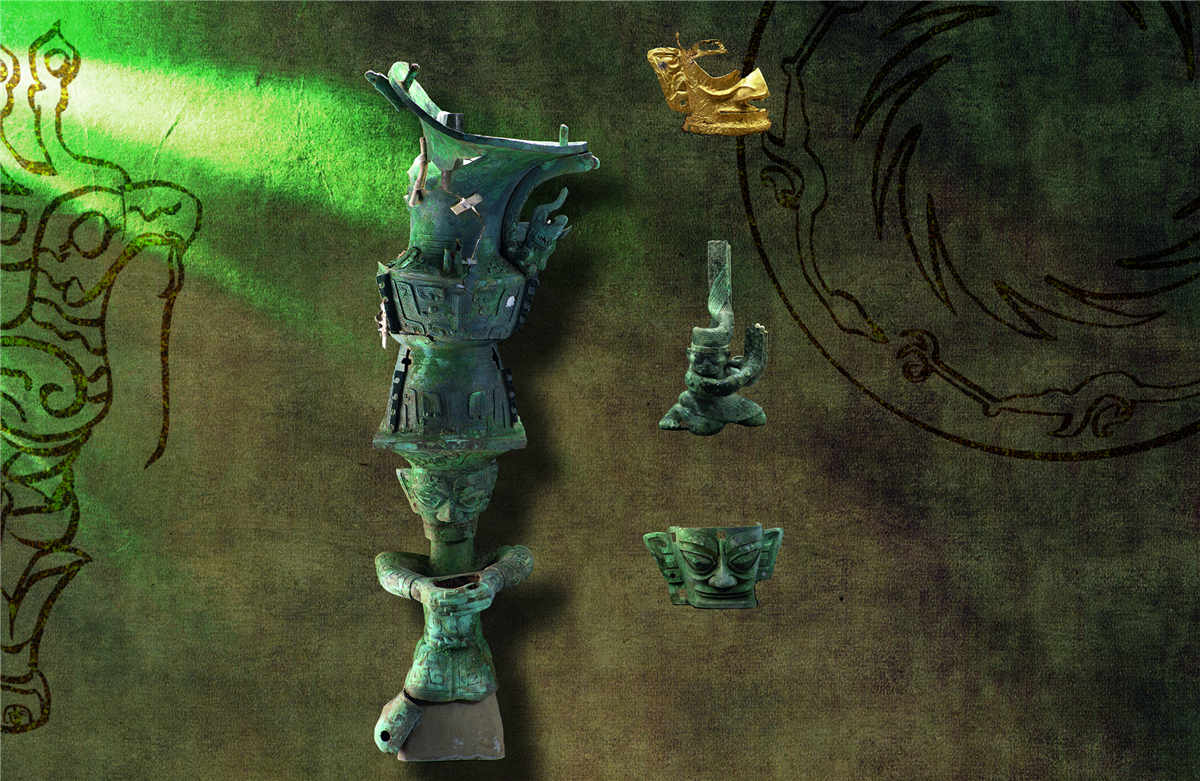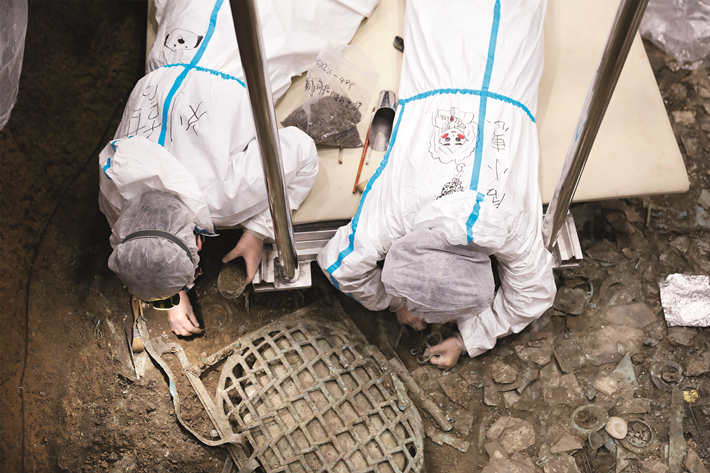The Sanxingdui Ruins: Amazing Ancient Shu Civilization

From June 13 to 15 this year, more than 10 million viewers were greeted with a livestreamed archaeological excavation at the Sanxingdui Ruins site located in Sichuan Province, known as Shu in ancient times. They witnessed how some prominent cultural relics in the No. 7 and No. 8 sacrificial pits were unearthed. A net-like bronze grid covering a tortoise-shell-shaped vessel with a green jade ware inside, for example, was discovered in the No. 7 pit. A delicate bronze altar and an imaginative human-head, snake-body, and bird-claw bronze figurine carrying a zun (a vessel for rituals) were excavated from the No. 8 pit. Unearthed items have evoked admiration for the shining and mysterious ancient Shu civilization dating back at least 4,800 years, and testified to the pattern of “diversity in unity” of Chinese civilization.
Emerging Relics
The Sanxingdui Ruins site covering an area of about 12 square kilometers was first discovered in the 1920s. In 1986, the excavation of two sacrificial pits demystified the site and marveled the world. Many precious cultural relics were unearthed including bronze statues, bronze sacred trees, gold rods, gold masks, ivories, and seashells, most of which had never been discovered before in China. Among them, artifacts featuring peculiar shapes and huge sizes were exemplified by an exaggerated bronze mask with protruding eyes, a towering bronze sculpture of a human figure, and a 3.95-meter-tall bronze “tree of life,” which made Sanxingdui stand out from its counterparts of the Bronze Age (approximately 3300 B.C. to 1200 B.C.). The site has also been crowned one of the greatest archaeological discoveries of the 20th century.
The sacrificial area includes the No. 1 and No. 2 pits excavated in 1986 and the six pits successively discovered since 2020. The incomplete gold mask unearthed in the No. 5 pit, for example, weighs about 280 grams and measures 28 centimeters in height and 23 centimeters in width. It was crowned the largest gold mask ever discovered from the era of the Shang (1600-1046 B.C.) and Zhou (1046-256 B.C.) dynasties, generally known as the Bronze Age of China. Also, ash on the surfaces of gold masks, bronze wares and other artifacts uncovered at the site turned out to be silk, advancing the origin of silk in the Sichuan Basin to over 3,000 years ago. Researchers used Carbon-14 dating to confirm that nearly 200 samples unearthed in different pits were made from 1131 B.C. to 1012 B.C., so they concluded that in addition to the No. 5 and No. 6 pits appearing later, the rest of the pits should have been built in the late Shang Dynasty.

Archaeologists in the No. 7 sacrificial pit excavate a net-like bronze grid covering a tortoise-shell-shaped vessel with green jade ware inside. The cute graffiti on the back of their protective clothing is visible while they lie flush against a suspended platform.
Since the 1980s, archaeologists have discovered and delineated a 3.6-square-kilometer core zone (the site of the ancient city of Sanxingdui) with an increasingly clear layout after repeated investigations, explorations, and trial excavations. Already, a capital city ruins site has emerged, consisting of multiple layers of city walls, oversized buildings, sacrificial pits, jade workshops, residential sites, early public cemeteries, and other important cultural relics.
The Sanxingdui Ruins site, characterized by distinctive regional characteristics and complex cultural landscapes, proves the existence of the ancient Shu civilization. Its highly developed bronze civilization shows that alongside the Yellow River Basin, the Yangtze River Basin was also an origin of Chinese civilization. Archaeological discoveries there have exerted profound influence locally, domestically, and even worldwide, noted Sun Hua, professor at Peking University’s School of Archaeology and Museology and also an academic consultant and technical supervisor for excavation of the Sanxingdui pits.
Young Forces
In the winter of 2020, the second round of archaeological excavations officially kicked off, mainly around the six newly discovered sacrificial pits at the Sanxingdui Ruins site. Alongside the eye-catching and precious cultural relics, a group of young archaeologists usually busy shoveling soil and recording data were also in the livestreaming spotlight. About 200 staffers have been participating in excavation and follow-up protection of cultural relics, and over 75 percent are from the generation born in the 1990s. Youngsters have become an indispensable force piecing together the Sanxingdui Ruins site and even Chinese archaeology at large.
Xu Danyang, born in 1995, was mainly responsible for extracting two precious bronze rings from the No. 4 pit in March 2021. His work on archaeological excavations at the site dates back to 2020 when he was a fresh master’s graduate of Peking University’s School of Archaeology and Museology. During the 2021 mission, he successfully unearthed the first bronze ring alone and then cooperated with colleague Zhou Shanshan, also born in the 1990s, to excavate the second. While lying flush against a suspended platform, archaeologists must rise to the challenge of concentrating all of their strength on their hands to excavate with their wrists and fingers alone. This is how they prevent a platform from shaking and hand shovels from touching cultural relics and causing damage. “It is a normal practice and not that tiring,” smiled Xu.

Cai Ning (second right, front), head of the No. 8 sacrificial pit excavation team who was born in 1994, poses with his teammates. The No. 8 pit is the largest among the six newly discovered sacrificial pits at the Sanxingdui Ruins site and hence boasts the most plentiful cultural relics. (Photo by Yu Jia)
Cai Ning, born in 1994, led excavation work in the No. 8 pit after finishing his research as a postdoctoral fellow of Peking University’s School of Archaeology and Museology in March 2021. He excavated in the daytime and spent his nights studying the thick excavation reports of the No. 1 and No. 2 sacrificial pits as well as various related papers, which inspired him a lot.
Xu Feihong, born in 1990, oversaw excavation of the No. 3 pit. As a young lecturer at Shanghai University’s College of Liberal Arts, he led a team with an average age of only 25 to work on the site for over 10 consecutive months in 2021. More than 1,000 cultural relics of various types were unearthed from the pit including 120-plus ivories and myriad small objects like seashells, enabling it to top the six sacrificial pits in terms of richness of unearthed artifacts. “Modern archaeology now involves far more than excavating cultural relics. It demands critical thinking and lifetime learning to master comprehensive literacy, far beyond the scope of traditional liberal arts,” Xu said.
To ensure the artifacts were not contaminated, those entering pits were required to wear a full set of protective clothing. Young archaeologists often decorated the suits with various graffiti such as cartoon characters from One Piece, a Japanese manga series, as well as personalized slogans such as “The Great Wall will never fall” and “Facing the gold.” Their enthusiasm has helped the dynamic and creative spirit of young Chinese archaeologists spread worldwide.
Site Archives:
Time of discovery: 1929
Location: Sanxingdui Town, Guanghan City, Sichuan Province
Historical period: From the late Neolithic Age to the early Spring and Autumn Period (approximately 4,800-2,600 years ago)
Area: 12 square kilometers
One of the greatest archaeological discoveries of the 20th century;
One of “China’s top 100 archaeological findings in the past 100 years”